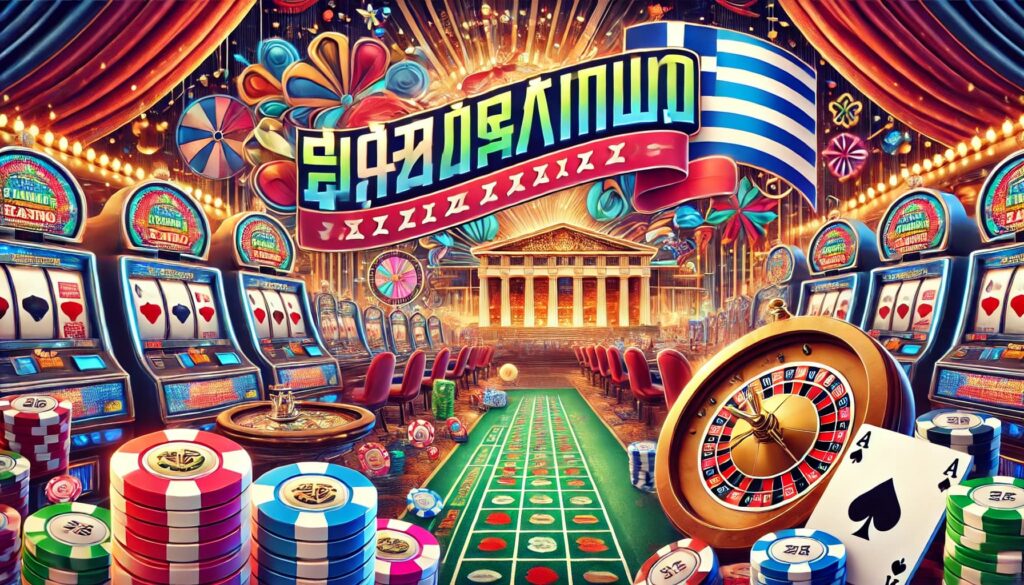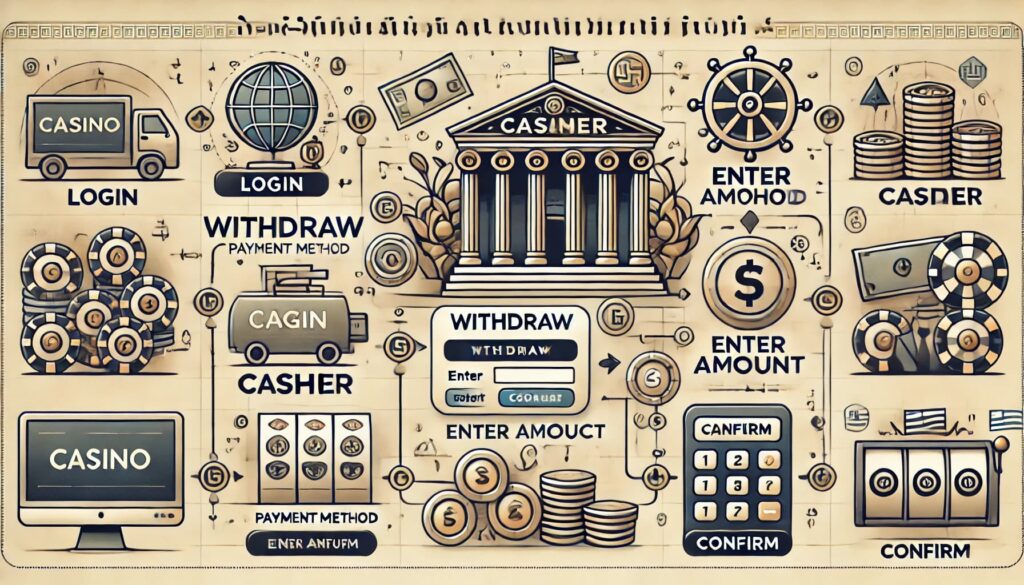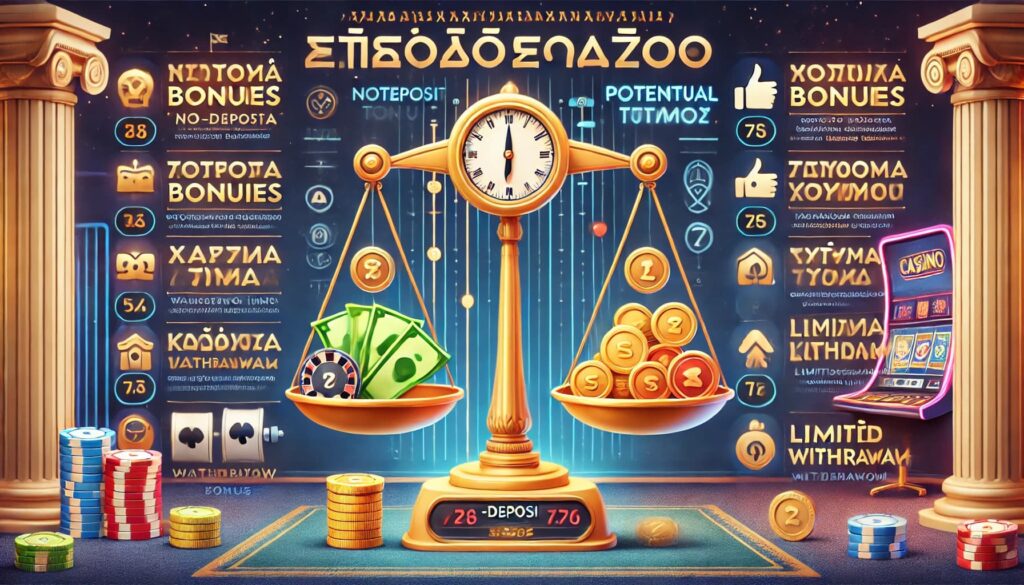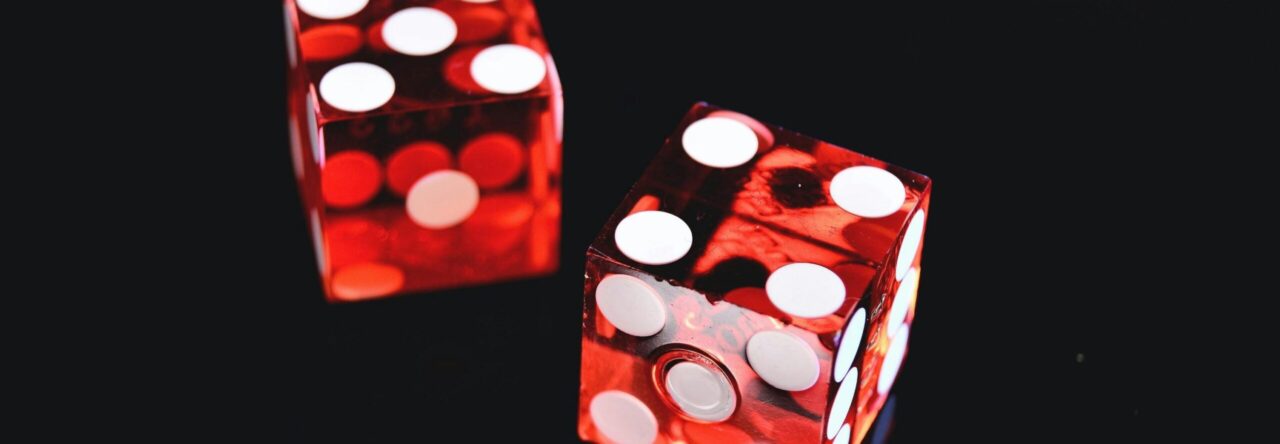
Ψάχνετε έναν τρόπο να ξεκινήσετε το παιχνίδι σας χωρίς κανένα οικονομικό ρίσκο; Σας έχουμε την τέλεια λύση! Τα ελληνικά καζίνο με μπόνους χωρίς κατάθεση σας επιτρέπουν να απολαύσετε τα αγαπημένα σας παιχνίδια χωρίς να χρειαστεί να κάνετε κατάθεση χρημάτων. Είτε είστε νέος παίκτης που θέλει να δοκιμάσει την τύχη του, είτε έμπειρος παίκτης που αναζητά νέες ευκαιρίες, τα μπόνους χωρίς κατάθεση αποτελούν την ιδανική επιλογή για όλους.
Στην ιστοσελίδα μας, θα βρείτε όλες τις πληροφορίες που χρειάζεστε για να διεκδικήσετε αυτά τα μοναδικά μπόνους. Από τα καζίνο που τα προσφέρουν μέχρι τους όρους και τις προϋποθέσεις χρήσης τους, σας καθοδηγούμε βήμα-βήμα για να κάνετε τη σωστή επιλογή. Ακόμα, θα ανακαλύψετε ποια είναι τα πιο αξιόπιστα καζίνο που προσφέρουν μπόνους χωρίς κατάθεση, καθώς και τα παιχνίδια που μπορείτε να απολαύσετε με αυτά.
Μην χάνετε χρόνο! Κάντε τώρα την πρώτη σας εγγραφή και αποκτήστε πρόσβαση σε συναρπαστικά μπόνους που σας δίνουν τη δυνατότητα να κερδίσετε χωρίς να ρισκάρετε τα δικά σας χρήματα. Κάντε κλικ στον παρακάτω σύνδεσμο και εξερευνήστε έναν κόσμο γεμάτο δράση, διασκέδαση και κέρδη!
Ξεκινήστε σήμερα στα ελληνικά καζίνο με μπόνους χωρίς κατάθεση και δείτε πόσο εύκολο είναι να κερδίσετε, χωρίς να επενδύσετε ούτε ένα ευρώ!
Τα Καλύτερα Ελληνικά Καζίνο με Μπόνους Χωρίς Κατάθεση
Παρακάτω μπορείτε να δείτε έναν συγκριτικό πίνακα με τα κορυφαία ελληνικά καζίνο με μπόνους χωρίς κατάθεση. Κάθε καζίνο προσφέρει μοναδικά χαρακτηριστικά που κάνουν την εμπειρία παιχνιδιού ακόμα πιο απολαυστική!
| Καζίνο | Έτος Ίδρυσης | Ιδιοκτήτης | Άδεια | Παιχνίδια | Μπόνους Χωρίς Κατάθεση |
| Billybets | 2019 | Billy Group N.V. | Κουρασάο | Κουλοχέρηδες, Ζωντανό Καζίνο | Ναι |
| MrPacho | 2020 | Pacho Gaming Ltd. | Μάλτα (MGA) | Επιτραπέζια, Στοίχημα | Ναι |
| Win Legends | 2021 | Win Legends Ltd. | Κουρασάο | Προοδευτικά Τζακπότ | Ναι |
| Posido | 2022 | Posido Entertainment | Κύπρος (CySEC) | Ρουλέτα, Πόκερ | Ναι |
| Sportaza | 2021 | Rabidi N.V. | Κουρασάο | Αθλητικά Στοιχήματα | Ναι |
Billybets
Το Billybets είναι ένα από τα πιο δημοφιλή ελληνικά καζίνο με μπόνους χωρίς κατάθεση, ιδρύθηκε το 2019 από την Billy Group N.V. Διαθέτει άδεια από το Κουρασάο, εξασφαλίζοντας ασφαλές και δίκαιο παιχνίδι. Η πλατφόρμα προστατεύεται με SSL κρυπτογράφηση, διασφαλίζοντας τα προσωπικά σας δεδομένα. Συνεργάζεται με γνωστούς παρόχους λογισμικού όπως NetEnt και Microgaming, προσφέροντας κουλοχέρηδες, ζωντανό καζίνο και πολλά άλλα. Είναι ιδανικό για όσους θέλουν να ξεκινήσουν με μπόνους χωρίς κατάθεση.
MrPacho
Το MrPacho, που ιδρύθηκε το 2020, ανήκει στην Pacho Gaming Ltd. και λειτουργεί με άδεια από την Αρχή Παιγνίων της Μάλτας (MGA). Με τεχνολογία SSL, εξασφαλίζει την ασφάλεια των συναλλαγών σας. Παρέχει μια ευρεία γκάμα παιχνιδιών, όπως επιτραπέζια παιχνίδια και αθλητικό στοίχημα, συνεργαζόμενο με κορυφαίους παρόχους όπως Play’n GO και Pragmatic Play. Το μπόνους χωρίς κατάθεση του MrPacho είναι ιδανικό για νέους παίκτες που θέλουν να δοκιμάσουν τις δυνατότητές τους χωρίς ρίσκο.
Win Legends
Το Win Legends, που ξεκίνησε τη λειτουργία του το 2021, προσφέρει μια μοναδική εμπειρία παιχνιδιού. Με άδεια από το Κουρασάο και προηγμένα μέτρα ασφαλείας όπως SSL, εγγυάται την προστασία σας. Η πλατφόρμα εξειδικεύεται σε προοδευτικά τζακπότ, προσφέροντας ευκαιρίες για μεγάλα κέρδη. Συνεργάζεται με κορυφαίους παρόχους όπως Evolution Gaming και Yggdrasil, εξασφαλίζοντας ποιοτική ψυχαγωγία. Είναι ιδανικό για παίκτες που αναζητούν κάτι ιδιαίτερο.
Posido
Το Posido αποτελεί έναν ανερχόμενο αστέρα στον κόσμο των ελληνικών καζίνο, ιδρύθηκε το 2022 από την Posido Entertainment. Με έδρα την Κύπρο και άδεια από την CySEC, παρέχει απόλυτη ασφάλεια και αξιοπιστία. Οι παίκτες μπορούν να απολαύσουν παιχνίδια όπως ρουλέτα, μπλακτζάκ και πόκερ από κορυφαίους παρόχους όπως Playtech και Betsoft. Το μπόνους χωρίς κατάθεση το κάνει να ξεχωρίζει από τον ανταγωνισμό.
Sportaza
Το Sportaza, που εμφανίστηκε το 2021, ανήκει στην Rabidi N.V. και λειτουργεί με άδεια από το Κουρασάο. Είναι γνωστό για τη μεγάλη του ποικιλία σε αθλητικά στοιχήματα, αλλά και για τα καζίνο παιχνίδια του, συνεργαζόμενο με παρόχους όπως Quickspin και iSoftBet. Με την προηγμένη κρυπτογράφηση του, προσφέρει ένα ασφαλές περιβάλλον για διασκέδαση. Το μπόνους χωρίς κατάθεση σας επιτρέπει να εξερευνήσετε τις δυνατότητές του χωρίς οικονομική δέσμευση.
Μέγιστη Αξιοποίηση των Επιλογών Πληρωμής για Καταθέσεις και Αναλήψεις στα Ελληνικά Καζίνο με Μπόνους Χωρίς Κατάθεση
Για να απολαύσετε πλήρως την εμπειρία σας στα ελληνικά καζίνο με μπόνους χωρίς κατάθεση, είναι σημαντικό να γνωρίζετε τις διαθέσιμες μεθόδους πληρωμής για καταθέσεις και αναλήψεις. Παρακάτω παρουσιάζουμε έναν πίνακα με τις κύριες μεθόδους πληρωμής που προσφέρονται από τα καζίνο Billybets, MrPacho, Win Legends, Posido και Sportaza.
| Καζίνο | Πιστωτικές/Χρεωστικές Κάρτες | Ηλεκτρονικά Πορτοφόλια | Τραπεζικές Μεταφορές | Προπληρωμένες Κάρτες | Κρυπτονομίσματα |
| Billybets | Visa, Mastercard | Skrill, Neteller | Ναι | Paysafecard | Ναι |
| MrPacho | Visa, Mastercard | Skrill, Neteller | Ναι | Paysafecard | Όχι |
| Win Legends | Visa, Mastercard | Skrill, Neteller | Ναι | Paysafecard | Ναι |
| Posido | Visa, Mastercard | Skrill, Neteller | Ναι | Paysafecard | Όχι |
| Sportaza | Visa, Mastercard | Skrill, Neteller | Ναι | Paysafecard | Ναι |
Πιστωτικές/Χρεωστικές Κάρτες
Οι πιστωτικές και χρεωστικές κάρτες, όπως η Visa και η Mastercard, είναι από τις πιο διαδεδομένες μεθόδους πληρωμής στα διαδικτυακά καζίνο. Προσφέρουν άμεσες καταθέσεις και υψηλό επίπεδο ασφάλειας. Τα περισσότερα από τα προαναφερθέντα καζίνο, όπως τα Billybets, MrPacho, Win Legends, Posido και Sportaza, δέχονται αυτές τις κάρτες για καταθέσεις και αναλήψεις.
Ηλεκτρονικά Πορτοφόλια
Τα ηλεκτρονικά πορτοφόλια, όπως το Skrill και το Neteller, προσφέρουν γρήγορες και ασφαλείς συναλλαγές. Επιτρέπουν στους παίκτες να διαχειρίζονται τα κεφάλαιά τους χωρίς να κοινοποιούν τα τραπεζικά τους στοιχεία. Καζίνο όπως τα Billybets, MrPacho, Win Legends, Posido και Sportaza υποστηρίζουν αυτές τις μεθόδους πληρωμής.
Τραπεζικές Μεταφορές
Οι τραπεζικές μεταφορές είναι μια αξιόπιστη μέθοδος για μεγαλύτερες συναλλαγές. Αν και οι χρόνοι επεξεργασίας μπορεί να είναι μεγαλύτεροι σε σύγκριση με άλλες μεθόδους, προσφέρουν υψηλό επίπεδο ασφάλειας. Όλα τα προαναφερθέντα καζίνο υποστηρίζουν τραπεζικές μεταφορές για καταθέσεις και αναλήψεις.
Προπληρωμένες Κάρτες
Οι προπληρωμένες κάρτες, όπως η Paysafecard, επιτρέπουν στους παίκτες να καταθέτουν χρήματα χωρίς να χρησιμοποιούν τραπεζικό λογαριασμό ή πιστωτική κάρτα. Είναι ιδανικές για όσους επιθυμούν να ελέγχουν τον προϋπολογισμό τους. Καζίνο όπως τα Billybets, MrPacho, Win Legends, Posido και Sportaza δέχονται προπληρωμένες κάρτες για καταθέσεις.
Κρυπτονομίσματα
Ορισμένα καζίνο, όπως τα Billybets, Win Legends και Sportaza, έχουν ενσωματώσει κρυπτονομίσματα ως μέθοδο πληρωμής, προσφέροντας ανωνυμία και ταχύτητα στις συναλλαγές. Τα κρυπτονομίσματα, όπως το Bitcoin, γίνονται ολοένα και πιο δημοφιλή στους παίκτες που αναζητούν εναλλακτικές μεθόδους πληρωμής.
Επιλέγοντας την κατάλληλη μέθοδο πληρωμής, μπορείτε να βελτιώσετε την εμπειρία σας στα ελληνικά καζίνο με μπόνους χωρίς κατάθεση, εξασφαλίζοντας γρήγορες και ασφαλείς συναλλαγές.
Οδηγίες Βήμα-Βήμα για την Ανάληψη Χρημάτων στα Ελληνικά Καζίνο με Μπόνους Χωρίς Κατάθεση

Ακολουθήστε τα παρακάτω βήματα για να κάνετε ανάληψη χρημάτων από τα ελληνικά καζίνο με μπόνους χωρίς κατάθεση:
- Συνδεθείτε: Χρησιμοποιήστε το όνομα χρήστη και τον κωδικό πρόσβασής σας για να συνδεθείτε στον λογαριασμό σας.
- Μεταβείτε στο Ταμείο: Κάντε κλικ στην επιλογή “Ταμείο” ή “Κατάθεση/Ανάληψη” από το κύριο μενού.
- Κάντε Κλικ στο Κουμπί Ανάληψης: Επιλέξτε την καρτέλα “Ανάληψη” από τις διαθέσιμες επιλογές.
- Επιλέξτε Μέθοδο Πληρωμής: Διαλέξτε τη μέθοδο που θέλετε να χρησιμοποιήσετε για την ανάληψη, όπως τραπεζική μεταφορά, ηλεκτρονικό πορτοφόλι ή κάρτα.
- Καταχωρήστε το Ποσό: Εισάγετε το ποσό που θέλετε να αποσύρετε, λαμβάνοντας υπόψη τα όρια του καζίνο.
- Επιβεβαιώστε την Εντολή: Ελέγξτε τις λεπτομέρειες της συναλλαγής σας και επιβεβαιώστε την ανάληψη.
Πριν την Ανάληψη: Επαλήθευση Λογαριασμού
Πριν από την πρώτη σας ανάληψη, είναι απαραίτητο να ολοκληρώσετε τη διαδικασία επαλήθευσης. Ακολουθήστε τα παρακάτω βήματα:
- Υποβολή Εγγράφων: Συνδεθείτε στον λογαριασμό σας και μεταβείτε στην ενότητα “Επαλήθευση”.
- Ανεβάστε Ταυτότητα ή Διαβατήριο: Στείλτε ένα έγκυρο αντίγραφο ταυτότητας ή διαβατηρίου για την επιβεβαίωση της ηλικίας και του ονόματός σας.
- Παρέχετε Απόδειξη Διεύθυνσης: Στείλτε έναν λογαριασμό κοινής ωφέλειας ή τραπεζικό αντίγραφο που να δείχνει τη διεύθυνσή σας.
- Επιβεβαιώστε τη Μέθοδο Πληρωμής: Στείλτε απόδειξη για τη μέθοδο που χρησιμοποιήσατε για την κατάθεση, όπως φωτογραφία της κάρτας ή στιγμιότυπο από το ηλεκτρονικό πορτοφόλι.
- Περιμένετε Έγκριση: Το καζίνο θα εξετάσει τα έγγραφα και θα σας ενημερώσει όταν ολοκληρωθεί η επαλήθευση.
Όροι και Προϋποθέσεις για τις Αναλήψεις
Προτού ζητήσετε την ανάληψη των κερδών σας από ελληνικά καζίνο με μπόνους χωρίς κατάθεση, βεβαιωθείτε ότι πληροίτε τους παρακάτω όρους και προϋποθέσεις:
- Ελέγξτε τα Όρια Ανάληψης: Βεβαιωθείτε ότι το ποσό που θέλετε να αποσύρετε είναι εντός των ελάχιστων και μέγιστων ορίων που ορίζει το καζίνο.
- Ικανοποιήστε τις Απαιτήσεις Στοιχηματισμού: Εάν έχετε χρησιμοποιήσει μπόνους χωρίς κατάθεση, πρέπει να ολοκληρώσετε τις απαιτήσεις στοιχηματισμού πριν από την ανάληψη.
- Επαληθεύστε τον Λογαριασμό Σας: Συμπληρώστε τη διαδικασία επαλήθευσης παρέχοντας τα απαραίτητα έγγραφα για την ταυτότητα, τη μέθοδο πληρωμής, το email, τον αριθμό τηλεφώνου και τη διεύθυνσή σας.
- Χρησιμοποιήστε την Επιλεγμένη Μέθοδο Κατάθεσης: Σε ορισμένα καζίνο, απαιτείται να χρησιμοποιήσετε την ίδια μέθοδο για κατάθεση και ανάληψη για λόγους ασφαλείας.
Με τη σωστή τήρηση των παραπάνω, μπορείτε να διασφαλίσετε γρήγορες και απρόσκοπτες αναλήψεις στα αγαπημένα σας ελληνικά καζίνο.
Συμβουλές για την Αποφυγή Καθυστερήσεων στις Αναλήψεις στα Ελληνικά Καζίνο με Μπόνους Χωρίς Κατάθεση
Η διαδικασία ανάληψης στα ελληνικά καζίνο με μπόνους χωρίς κατάθεση μπορεί να είναι απλή και γρήγορη, αρκεί να ακολουθήσετε ορισμένες χρήσιμες συμβουλές. Παρακάτω θα βρείτε σημαντικές πληροφορίες που θα σας βοηθήσουν να αποφύγετε καθυστερήσεις στις πληρωμές σας.
Ενημερωθείτε για τις Πολιτικές και τα Όρια Πληρωμών του Καζίνο
Προτού προχωρήσετε σε οποιαδήποτε ανάληψη, βεβαιωθείτε ότι γνωρίζετε τις πολιτικές του καζίνο σχετικά με τις πληρωμές. Ελέγξτε τα ελάχιστα και μέγιστα όρια ανάληψης, καθώς και τον προβλεπόμενο χρόνο επεξεργασίας των αιτημάτων σας. Με αυτόν τον τρόπο, αποφεύγετε εκπλήξεις και καθυστερήσεις.
Τηρήστε τους Όρους και Προϋποθέσεις του Καζίνο
Η παραβίαση των όρων χρήσης του καζίνο μπορεί να οδηγήσει σε καθυστερήσεις ή ακόμα και στην ακύρωση της ανάληψης. Διαβάστε προσεκτικά τους όρους και προϋποθέσεις, ώστε να κατανοήσετε πλήρως τους κανόνες και να αποφύγετε παρερμηνείες.
Ελέγξτε Έγκαιρα τον Λογαριασμό Σας
Βεβαιωθείτε ότι ο λογαριασμός σας είναι πλήρως επαληθευμένος και ότι έχετε υποβάλει έγκυρα έγγραφα με ακριβή στοιχεία. Η γρήγορη ολοκλήρωση της διαδικασίας επαλήθευσης είναι το κλειδί για την αποφυγή καθυστερήσεων στις πληρωμές. Ελέγξτε περιοδικά την κατάσταση του λογαριασμού σας για να διασφαλίσετε ότι όλα είναι εντάξει.
Επιλέξτε Μια Ευνοϊκή Μέθοδο Πληρωμής
Η επιλογή της σωστής μεθόδου πληρωμής μπορεί να επηρεάσει σημαντικά τον χρόνο που απαιτείται για την ολοκλήρωση της ανάληψης. Προτιμήστε μεθόδους που προσφέρουν γρήγορες και απρόσκοπτες συναλλαγές, όπως ηλεκτρονικά πορτοφόλια ή τραπεζικές μεταφορές.
Επωφεληθείτε από Προγράμματα Επιβράβευσης
Πολλά καζίνο προσφέρουν προγράμματα επιβράβευσης για πιστούς παίκτες, τα οποία περιλαμβάνουν ταχύτερες πληρωμές και υψηλότερα όρια ανάληψης. Εξετάστε αν το καζίνο σας προσφέρει τέτοια προγράμματα και αξιοποιήστε τα για να κάνετε τη διαδικασία ανάληψης πιο ομαλή.
Ακολουθώντας αυτές τις συμβουλές, θα διασφαλίσετε ότι η εμπειρία σας στα ελληνικά καζίνο με μπόνους χωρίς κατάθεση είναι ευχάριστη και χωρίς καθυστερήσεις στις πληρωμές σας.
Κριτήρια για την Επιλογή των Καλύτερων Ελληνικών Καζίνο με Μπόνους Χωρίς Κατάθεση
Όταν επιλέγετε ένα ελληνικό καζίνο με μπόνους χωρίς κατάθεση, υπάρχουν ορισμένα βασικά κριτήρια που μπορείτε να λάβετε υπόψη για να εξασφαλίσετε την καλύτερη εμπειρία παιχνιδιού. Παρακάτω σας παρουσιάζουμε τα σημαντικότερα κριτήρια που πρέπει να αξιολογήσετε:
- Άδεια και Αξιοπιστία
- Ποικιλία Παιχνιδιών
- Ποιότητα Μπόνους Χωρίς Κατάθεση
- Επιλογές Πληρωμών
- Εξυπηρέτηση Πελατών
- Κριτικές και Αξιολογήσεις
Άδεια και Αξιοπιστία
Πάντα να προτιμάτε καζίνο που διαθέτουν άδεια από αναγνωρισμένες ρυθμιστικές αρχές, όπως η MGA (Μάλτα), το Κουρασάο ή η ΕΕΕΠ (Ελλάδα). Αυτό διασφαλίζει την ασφάλεια των συναλλαγών σας, τη δικαιοσύνη των παιχνιδιών και την προστασία των προσωπικών σας δεδομένων.
Ποικιλία Παιχνιδιών
Η μεγάλη γκάμα παιχνιδιών είναι σημαντική για την εμπειρία σας. Ελέγξτε αν το καζίνο προσφέρει κουλοχέρηδες, επιτραπέζια παιχνίδια, ζωντανό καζίνο και άλλες επιλογές. Σημαντικό επίσης είναι να συνεργάζεται με κορυφαίους παρόχους λογισμικού, όπως NetEnt, Microgaming και Evolution Gaming.
Ποιότητα Μπόνους Χωρίς Κατάθεση
Το μπόνους χωρίς κατάθεση αποτελεί έναν βασικό παράγοντα για την επιλογή καζίνο. Ελέγξτε το ποσό του μπόνους, τις απαιτήσεις στοιχηματισμού και τους όρους χρήσης. Επιλέξτε καζίνο που προσφέρουν γενναιόδωρα μπόνους με εύκολους όρους.
Επιλογές Πληρωμών
Η ποικιλία και η ευκολία στις πληρωμές είναι καθοριστικής σημασίας. Αναζητήστε καζίνο που υποστηρίζουν δημοφιλείς μεθόδους όπως Visa, Skrill, Neteller, τραπεζικές μεταφορές και κρυπτονομίσματα. Ελέγξτε επίσης τους χρόνους επεξεργασίας για αναλήψεις.
Εξυπηρέτηση Πελατών
Ένα καλό καζίνο πρέπει να προσφέρει άμεση και φιλική εξυπηρέτηση πελατών. Δείτε αν παρέχει υποστήριξη μέσω live chat, email ή τηλεφώνου, καθώς και αν λειτουργεί 24/7.
Κριτικές και Αξιολογήσεις
Διαβάστε κριτικές από άλλους παίκτες για να αποκτήσετε καλύτερη εικόνα για την αξιοπιστία και την ποιότητα του καζίνο. Ελέγξτε εξειδικευμένες ιστοσελίδες που αξιολογούν καζίνο για να συγκρίνετε τις επιλογές σας.
Ακολουθώντας αυτά τα κριτήρια, μπορείτε να επιλέξετε τα καλύτερα ελληνικά καζίνο με μπόνους χωρίς κατάθεση και να απολαύσετε μία μοναδική εμπειρία παιχνιδιού.
Πλεονεκτήματα και Μειονεκτήματα των Ελληνικών Καζίνο με Μπόνους Χωρίς Κατάθεση

Ο παρακάτω πίνακας περιγράφει τα βασικά πλεονεκτήματα και μειονεκτήματα των ελληνικών καζίνο με μπόνους χωρίς κατάθεση, βοηθώντας σας να κατανοήσετε καλύτερα αν είναι η σωστή επιλογή για εσάς.
| Πλεονεκτήματα | Μειονεκτήματα |
| Δεν απαιτείται αρχική κατάθεση, δίνοντας τη δυνατότητα να παίξετε δωρεάν. | Συχνά συνοδεύεται από αυστηρές απαιτήσεις στοιχηματισμού, που μπορεί να δυσκολέψουν την ανάληψη των κερδών. |
| Ιδανικό για νέους παίκτες που θέλουν να δοκιμάσουν το καζίνο χωρίς να ρισκάρουν τα χρήματά τους. | Ορισμένα μπόνους έχουν περιορισμένη διάρκεια ισχύος, κάτι που απαιτεί γρήγορη εκμετάλλευση. |
| Παρέχει την ευκαιρία να δοκιμάσετε νέα παιχνίδια και πλατφόρμες χωρίς δέσμευση. | Μπορεί να υπάρχει περιορισμένος αριθμός παιχνιδιών που είναι επιλέξιμα για χρήση με το μπόνους. |
| Τα ελληνικά καζίνο με άδειες λειτουργίας εξασφαλίζουν ασφάλεια και αξιοπιστία στις συναλλαγές. | Ορισμένα καζίνο απαιτούν ολοκλήρωση εκτεταμένων διαδικασιών επαλήθευσης πριν από την ανάληψη κερδών από το μπόνους. |
| Υπάρχει δυνατότητα να κερδίσετε πραγματικά χρήματα χωρίς να επενδύσετε δικά σας. | Οι μέγιστες αναλήψεις που προέρχονται από μπόνους χωρίς κατάθεση είναι συχνά περιορισμένες, μειώνοντας την αξία των ενδεχόμενων κερδών. |
| Προωθείται διαφάνεια, καθώς μπορείτε να αξιολογήσετε την ποιότητα του καζίνο πριν αποφασίσετε να καταθέσετε χρήματα. | Οι επιλογές πληρωμών μπορεί να περιορίζονται για τους χρήστες που επιθυμούν να χρησιμοποιήσουν μπόνους χωρίς κατάθεση. |
Αξιολογώντας τα πλεονεκτήματα και τα μειονεκτήματα, μπορείτε να αποφασίσετε αν τα ελληνικά καζίνο με μπόνους χωρίς κατάθεση είναι κατάλληλα για τις ανάγκες και τις προσδοκίες σας.
Συχνές Ερωτήσεις για Ελληνικά Καζίνο με Μπόνους Χωρίς Κατάθεση
Τι είναι τα ελληνικά καζίνο με μπόνους χωρίς κατάθεση;
Πρόκειται για διαδικτυακά καζίνο που προσφέρουν δωρεάν μπόνους στους παίκτες χωρίς να απαιτείται αρχική κατάθεση, δίνοντας τη δυνατότητα να παίξουν δωρεάν.
Πώς μπορώ να διεκδικήσω ένα μπόνους χωρίς κατάθεση;
Συνήθως, χρειάζεται να εγγραφείτε στο καζίνο και να επαληθεύσετε τον λογαριασμό σας για να λάβετε το μπόνους.
Υπάρχουν περιορισμοί στη χρήση του μπόνους;
Ναι, ορισμένα παιχνίδια μπορεί να μην είναι επιλέξιμα και συχνά ισχύουν απαιτήσεις στοιχηματισμού που πρέπει να ολοκληρωθούν πριν την ανάληψη.
Μπορώ να κερδίσω πραγματικά χρήματα με μπόνους χωρίς κατάθεση;
Ναι, αλλά οι αναλήψεις είναι συνήθως περιορισμένες και απαιτούν την ολοκλήρωση των όρων του μπόνους.
Πρέπει να επαληθεύσω τον λογαριασμό μου για να κάνω ανάληψη;
Ναι, τα περισσότερα καζίνο απαιτούν επαλήθευση ταυτότητας, διεύθυνσης και μεθόδου πληρωμής για λόγους ασφαλείας.
Ποια είναι η διάρκεια ισχύος του μπόνους χωρίς κατάθεση;
Η διάρκεια ισχύος διαφέρει ανά καζίνο, αλλά συνήθως κυμαίνεται από λίγες ημέρες έως μία εβδομάδα.
Υπάρχουν κρυφές χρεώσεις κατά την ανάληψη των κερδών;
Όχι, αν και ορισμένες μέθοδοι πληρωμής μπορεί να επιβάλλουν προμήθειες, το καζίνο συνήθως αναφέρει ξεκάθαρα τις χρεώσεις.
